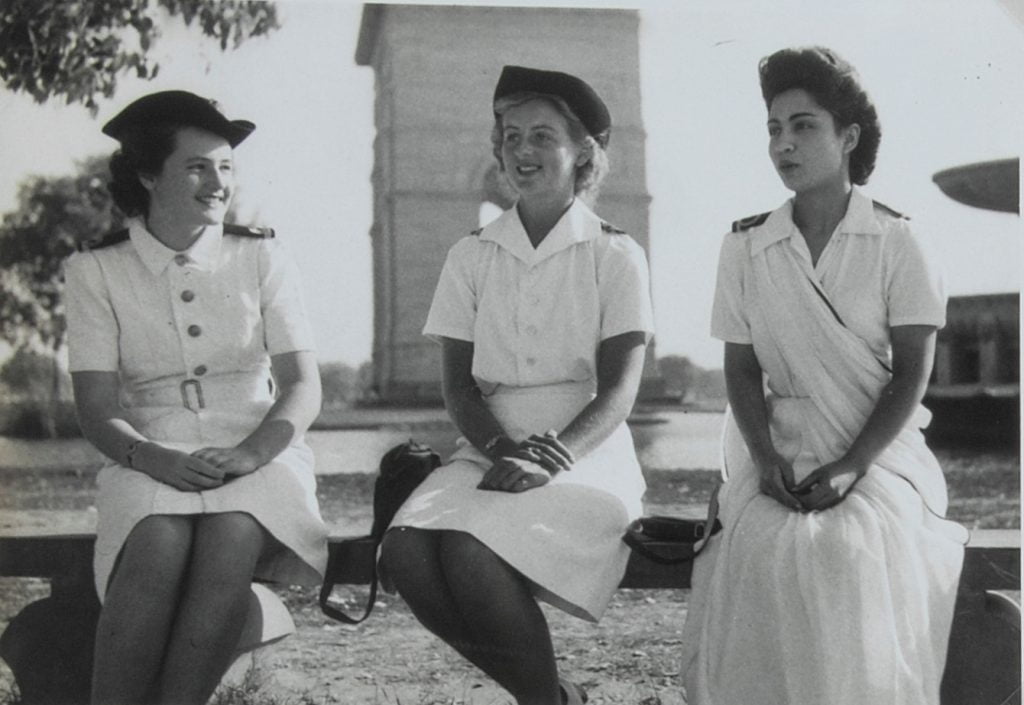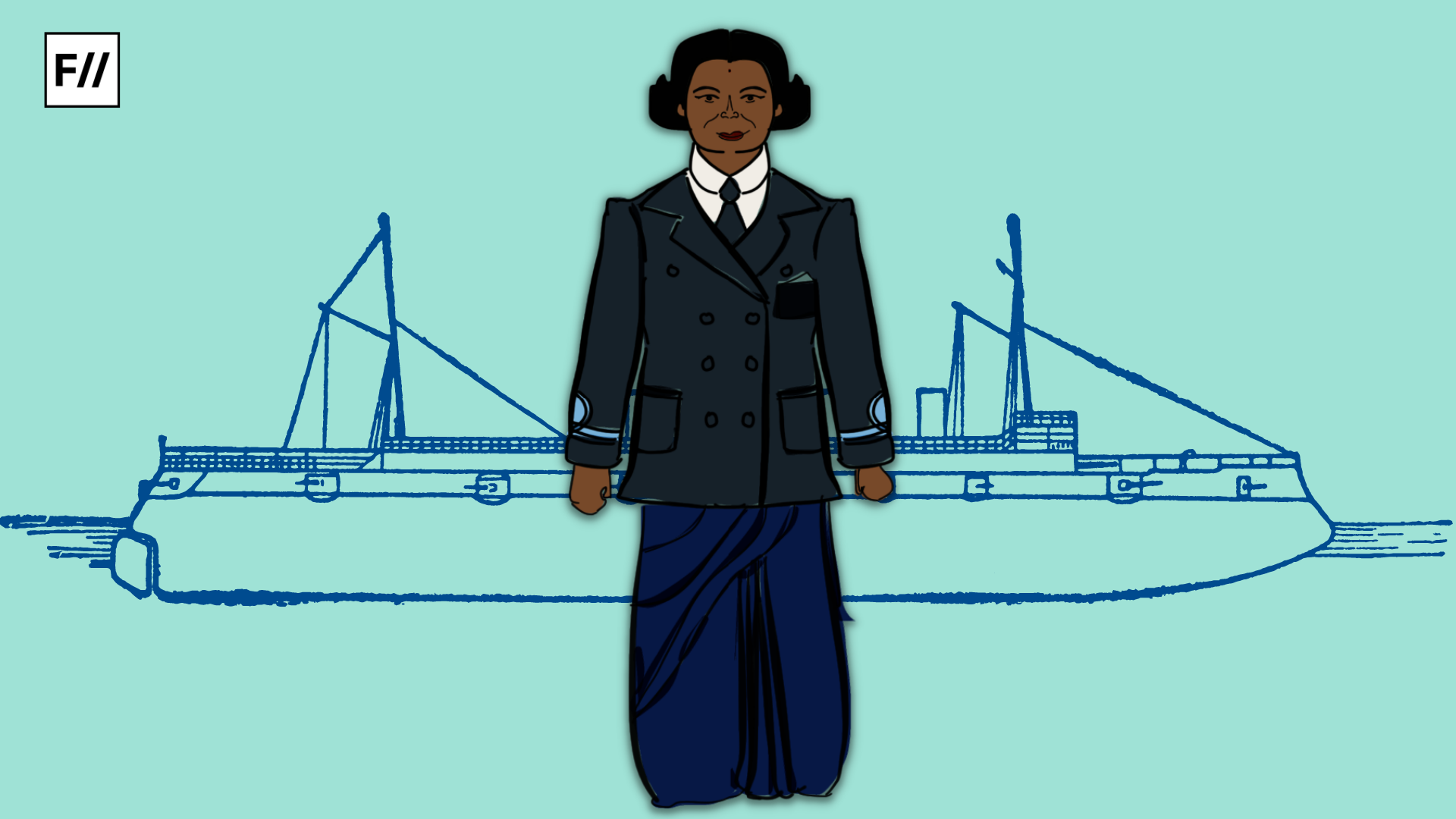The W.R.I.N.S or the Women’s Royal Indian Naval Service was formally set up in January 1944 as the naval wing of the Women’s Auxiliary Corps (India) in response to the increasing demand for labour to fill up “shore jobs” during the Second World War. Nearly three decades after the formation of their counterpart, the Women’s Royal Naval Service or the WRENS, the WRINS became a symbol of a new India, subverting gender norms and laying the steppingstone for a new, independent India and an emancipated Indian woman.
Though neither the WRINS nor the WRENS were allowed to go to sea, they became instrumental in naval life and played a vital role in defeating the enemy. They took up clerical roles, decoded secret messages, were trained in gunnery tactics, maintained equipment, and more. Through confidence, a sense of duty, and pride of service, these women were able to make a lasting difference, directly confronting issues that affect us today—those of caste, class, and gender inequality.
Source: The National Museum of the Royal Navy
Though neither the WRINS nor the WRENS were allowed to go to sea, they became instrumental in naval life and played a vital role in defeating the enemy. They took up clerical roles, decoded secret messages, were trained in gunnery tactics, maintained equipment, and more. Through confidence, a sense of duty, and pride of service, these women were able to make a lasting difference, directly confronting issues that affect us today—those of caste, class, and gender inequality.
How Women Came to Serve
Around 1917, during the First World War, The Women’s Royal Naval Service (WRNS/Wrens) was created in response to the desperate need for volunteers to fill up “shore jobs” such as motor drivers, cooks, clerks, etc., so that more men would be able to join the war efforts at sea. Previously involved in only medical tasks, these women became an inalienable part of the British war efforts.
Subsequently, during the Second World War, when the threat of the Japanese invasion of India began looming large, the British formed the Women’s Auxiliary Corps (India) or the W.A.C. in 1942 for women to contribute to the war cause. It was only in 1944 that the Women’s Royal Indian Naval Service (W.R.I.N.S.) was formed as the naval wing of the W.A.C.
The W.A.C. and the WRINS were the first and only time women served in the Indian Armed Forces in non-medical roles until 1992.
Source: The National Museum of the Royal Navy & The Better India
Source: The National Museum of the Royal Navy
Recruitment
Around 1944, newly promoted Chief Officer, Margaret Cooper, began conducting an intensive campaign in British India to recruit women to the WRINS. Her campaign was largely successful with middle and upper-class Indian women who were excited by the prospect of serving in the Army and aiding war efforts.
Due to the lack of research and testimonies on the WRINS, there have been many misconceptions regarding the composition of the wing. Many incorrectly believe that the WRINS were either British or ‘Anglo-Indian’; however, starting with 41 officers and 204 WRINS in January 1944, the strength of the WRINS at the end of 1945 was 242 officers and 746 WRINS. Of the women employed by the WRINS in 1945, nearly two-thirds were Indian nationals. The recruits, who were mostly college graduates and school teachers, lived in military-style hostels run by women officers and trained for a multitude of “shore jobs.”
The WRINS took part in discussions, debates, and general knowledge tests which proved invaluable in developing the skills and broadening the future outlook of Indian women. They were assigned specialist tasks such as top-secret decoding, training in gunnery tactics, and much more. Writing in 1945, Chief Officer Margaret Cooper claimed that, ‘…for the Indian girls, it was the experience of a lifetime and broadened their outlook considerably.’ The lack of Indian testimonies in British records, however, make it difficult to verify Cooper’s claims. Regardless, it is interesting to note that though the WRINS and WRENS came from drastically different backgrounds and upbringings, their differences in opinion were forgotten in lieu of helping the Navy in its time of need.
From From “Wrins and How They Served” Pg. 12 via Valentina Vitali (2019)
Also read: PK Thresia: The Woman Who Was India’s First Chief Engineer |…
Symbols of New India
Around 1945, Second Officer Kalyani Sen was issued an invitation by Britain’s Admiralty to visit the United Kingdom for a comparative study of training and administration in the WRNS. She was the first Indian service woman to visit the United Kingdom. Sen and her colleagues were aware of the controversial nature of the job but they chose to contribute to the effort out of a sense of duty regardless of the prejudices. In an interview with the Daily Herald, Sen said, “In India, there is still a big prejudice against women working with men. But the women are so keen to get into the Services that they are breaking it down.” During her visit, a picture of Sen in a white shirt and naval jacket with a gold braid over her sari was published in many major Indian publications. The picture began to be hailed as a symbol of “new India”—one where women unapologetically existed in the workplace alongside their male counterparts.

Source: The National Museum of the Royal Navy & The Better India
In the essay Women and nation revisited, Partha Chatterjee addresses the concept of the ‘new woman’ that arose as a consequence of the colonial enterprise and the nationalist project. The nationalist project aimed to create a ‘modern woman’ that was an object of aspiration for women themselves. While nationalism did assert the existence and value of tradition, it made space for a reformed understanding of cultural practices that conformed to the spaces of the modern world. Much like the sari and shirt attire of the WRINS, the ‘new Indian woman’ began to embody a link to both ‘modern ideology while maintaining the desire to preserve a culture. The spiritual freedom and self-emancipation of women became closely linked with the nationalist project. Women like the WRINS, who challenged prejudices, came to embody a revolutionary liberty that redefined the archetype of the post-colonial Indian woman. After leaving the WRINS, they were regarded as being a part of a progressive post-war India and promised a place of privilege.
While women from higher castes were able to fit into these redefined spaces due to their relative privilege, women from lower castes did not play a defining role. The ‘new Indian woman’ was expected to be educated, she was to acquire refined tastes, and eventually represent India in the global field but women from lower castes did not have the same opportunities to be educated and acquire ‘refined tastes’.
While women from higher castes were able to fit into these redefined spaces due to their relative privilege, women from lower castes did not play a defining role. The ‘new Indian woman’ was expected to be educated, she was to acquire refined tastes, and eventually represent India in the global field but women from lower castes did not have the same opportunities to be educated and acquire ‘refined tastes’.
Then vs. Now
In 1992, the Indian Army began inducting women officers in non-medical roles. In December 2018, the IAF had 13.09% women, the Navy had 6%, and the Army had 3.80%. On 17 February 2020, the Supreme Court of India said that women officers in Indian Army can get command positions at par with their male counterparts. While this is a step in the right direction in terms of inclusivity and egalitarianism in the field, as feminists it is important to recognise that the military and army have often been tools used by the government to further their own agenda, inciting war and looking past the loss of lives in the quest for power. Although such recruitment should be lauded, a war-like mentality and a hostile code of conduct should be adequately critiqued.
While the Indian Navy is moving toward a more inclusive landscape with women reaching positions such as Lieutenant-General and Vice admirals, there is a lot of work to be done to be truly inclusive. Unlike the army, which enables women to occupy command positions, the Navy is still against allowing women as sailors on warships. Women are recognised as capable soldiers and officers, but unlike the men, their capabilities are considered limited.
Also read: Feminist Decoding Of Kamasutra: A History Of Socio-Sexual Subjugation
Though the WRINS existed for only three years, the organisation provided a plethora of opportunities for middle-class, upper caste Indian women to be exposed to a global environment and experience a diversity of opportunities. In some regard, these women were pioneers of an Indian feminist sensibility that changed the dynamic of the Indian workforce. Their defiance of prejudices allowed young women to be emancipated from cultural norms that were holding them back. The WRINS created a global recognition and realisation of the capabilities of the Indian woman. In their unapologetic existence, they led a subtle revolution.
References
The Women’s Royal Indian Naval Service: Picturing India’s New Woman.
Featured Image Source: Ritika Banerjee for Feminism in India
About the author(s)
Aastha Jani was born in Surat, Gujarat and raised in Dubai, UAE. She is passionate about intersectional representation in popular media, dismantling gender roles, and confronting internalised misogyny. Aastha can usually be found binge-watching TV, baking brownies, or chasing a sunset.





I don’t follow the re.arks, “Though neither the WRINS nor the WRENS were allowed to go to sea, they became instrumental in naval life and played a vital role in defeating the enemy. They took up clerical roles, decoded secret messages, were trained in gunnery tactics, maintained equipment, and more.”
My mother was in the Wrns and travelled with the navy to India, Sri Lanka, Aden, Malta, Gibraltar. Further on in the article there’s a photo of Wrins talking to their fellow Wren counterparts. How did the Wrens get to India except by travelling with naval forces?
Hi Sharon! I can see how that statement would be confusing. To clarify, going “out to sea” was meant to imply participating in armed conflict as part of the naval forces. The paragraph you are referring to is sourced from the archives of the British National Museum of the Royal Navy, you can read more here: https://www.nmrn.org.uk/news-events/nmrn-blog/breaking-down-barriers-womens-royal-indian-naval-service
Thanks for your comment and I hope this clears up the confusion!
Great to know the history of how women came into joining the Naval service in India. I am sure articles like these need to be widely read and appreciated and the day would not be far when we could see the women in combat positions within the Navy.
Good research and presentation, keep up the good work.
HI,
When it is about just woman, and her achievements its a joy to read. Who needs to know about whether she was black, gay, Dalit or Brahmin. Woman have been discriminated against since forever and its THAT issue that needs to be talked about instead of diluting nad further segregating the matter which just weakens the issue. At least if the issue was broached in a non-contentious manner and just stated as a fact it would make sense BUT every time an article is written it’s either how this Gay woman was treated, this Muslim woman was ignored, this Dalit woman was treated badly etc. Etc. FEMINISM is not a divisible issue and the only way to achieve results of any importance is to stand together as WOMAN!!!